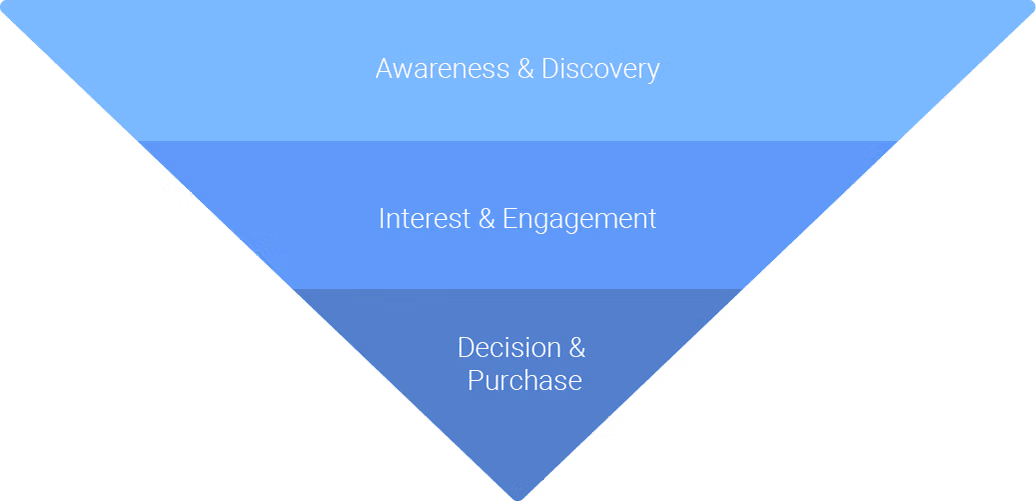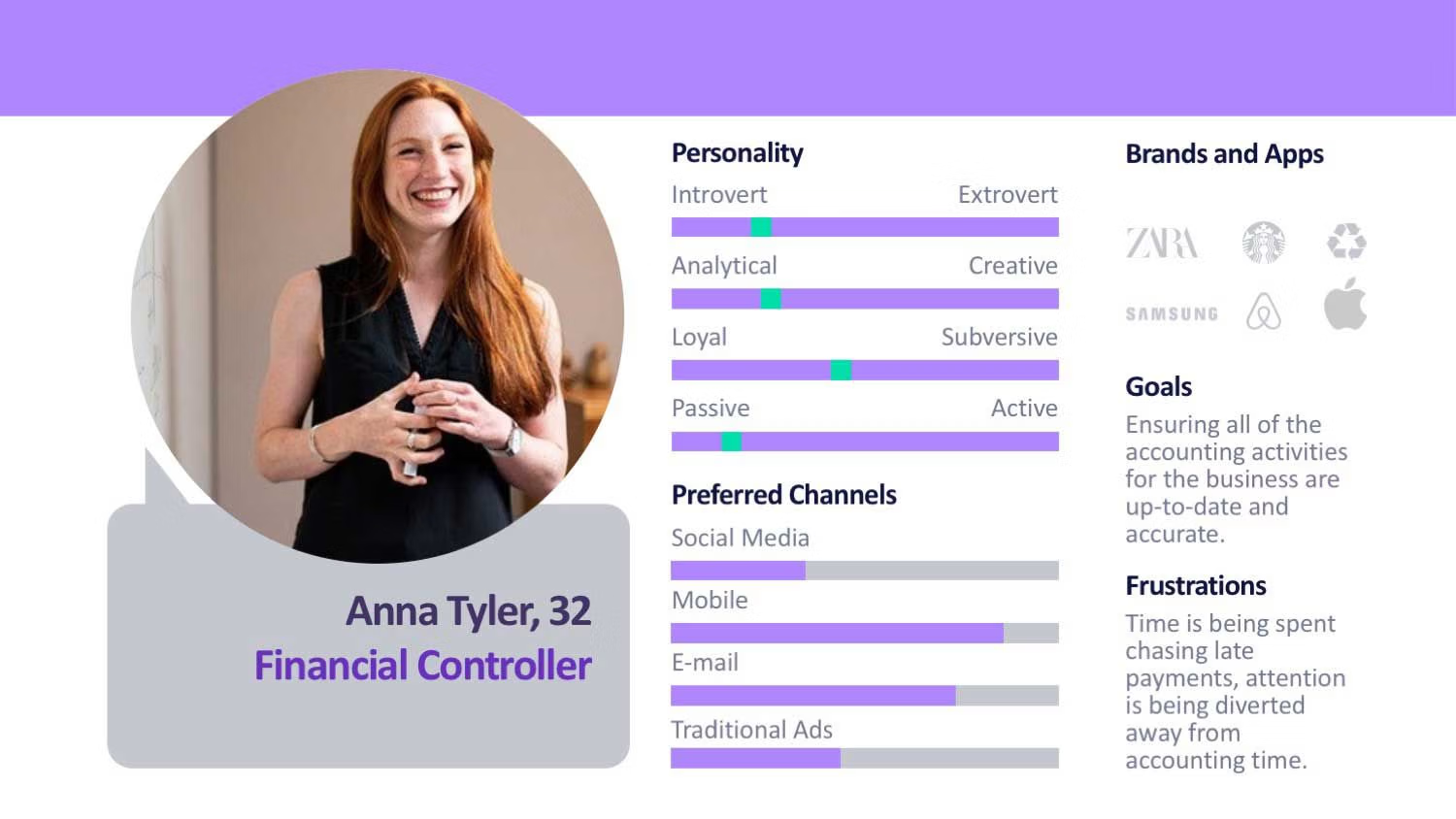Move Customers Through Your Sales Funnel With Ease
Updated December 15, 2021
6 min read

One of the most important aspects of any business is moving your customers through the sales funnel. Knowing the basics and fundamentals of this journey, it will help you increase your profits and overall ROI.
What is the sales funnel?
The sales funnel is the visual representation of the different stages of a customer’s sales process. It is from the very first click, all the way to the ‘end’ when you’ve made the sales and you have a happy, and hopefully returning customer.
There are three different stages in a typical business-to-business (B2B) sales funnel.
- Awareness & Discovery: these are the first moments that a customer comes into contact with your brand. This is also the top of the funnel.
- Interest & Engagement: this is the middle of the funnel, where they are searching through your site and gaining more information.
- Decision & Purchase: the ending portion of the funnel, where they have decided if they want to buy your product or service.
It’s important to remember that there are many variations of the sales funnel, which you can tailor to your specific niche. This is great when you’re able to have your specific sales journey with key CRM settings.
To create a high-performing sales funnel, you need to understand each stage of the process. These states are going to play into the customer psychology and drive your prospect awareness of your brand to finally win over that conversion.
 Your first step in the sales funnel is to build your brand’s awareness. You may think that just building your brand is enough and people will happen to stumble upon it and fall in love. Unfortunately, this is no rom-com. You are going to have to create content that raises awareness of your brand, the people behind your brand, and the products and services you sell. In this article, we will get into the nitty gritty of each step of the funnel.
Your first step in the sales funnel is to build your brand’s awareness. You may think that just building your brand is enough and people will happen to stumble upon it and fall in love. Unfortunately, this is no rom-com. You are going to have to create content that raises awareness of your brand, the people behind your brand, and the products and services you sell. In this article, we will get into the nitty gritty of each step of the funnel.Building Brand Awareness
This first phase, it’s all about your brand awareness and discovery. In this stage of the sales funnel, your prospects are coming into contact with your brand, product, or service for the first time. Remember the saying “You never get a second chance to make a first impression”, well keep that in mind. Regardless if you are a large or small business, this is the defining moment. This is the moment you create the narrative and explain your value to your prospects.
This stage is where people are engaging with your content online, going to your landing page, hearing more about you from another user, or seeing an advertisement you’ve been running.
To get started, think about yourself as a consumer. Ask yourself what type of content you would need to create to build awareness to attract prospective customers.
Think about:
- What do I need my prospects to understand about my company?
- What do they need to know before they will consider working with me?
- What objections would prevent someone from buying?
- What research are my prospects doing before they purchase?
Once you have answered these questions, the next step is to make a buyer persona.
A buyer persona is a fictional representation of the type of person that represents a member of the core demographic you’re trying to reach. This can range from the small business owner to first-time parent, middle school teacher, to plumber. There is no limit. Give them a name, goals, problems, desires, and preferences. The more specific the better.
The journey that someone takes to become a customer is really on a case-by-case basis. As not every person is the same, neither are their purchasing habits. This all depends on what the individuals are trying to accomplish or what they are looking for to solve their problems. In order to really understand the path that people take to your products, take some time to understand the people who actually buy from you.
But don’t go too crazy. They should be realistic and informed by real insights of your customers. You can do so through a customer survey. The more your buyer persona accurately represents an actual customer and the people who buy your products, the better. It will help you understand even more of the customer journey.
Creating buyer personas, it gives you a great exercise to get in the heads of your customers and improve your marketing efforts even more. It also makes it easier to understand every step of the customer journey.
 After you have crafted a detailed buyer persona, you can then start to focus on pinpointing the prospects’ needs. This means identifying any pain points in the industry and making sure you have solutions to them. Once you have an idea of the pain points, make it clear on your website or advertisements that you recognize them and are able to provide a solution.
After you have crafted a detailed buyer persona, you can then start to focus on pinpointing the prospects’ needs. This means identifying any pain points in the industry and making sure you have solutions to them. Once you have an idea of the pain points, make it clear on your website or advertisements that you recognize them and are able to provide a solution.Spark Interest and Engagement
In this phase of the sales journey, this is where prospects begin to show “interest and engagement” in your brand.
This signals that they are interested in learning more about your product or service or how you can help them solve a specific problem, and become better acquainted with the types of content that are speaking directly to them. The prospects that move from the top of the funnel to the middle have most likely made the decision if they will be spending money on a specific product, solution, or service that can solve their problem. This means, when they are sparking interest and engaging with your brand, you’re in the running to generate a new customer.
In this phase of the funnel, you need to showcase your unique selling proposition. This is what differentiates you from your competition. It is the compelling reason that makes your prospects choose you over your competitors.
A couple of tips to help establish your unique selling proposition:
- Analyze your competition
- Identify industry pain points
- Emphasize skills
- Cite specific examples and use social proof
- Monitor and adapt based on customer feedback
With your personalized selling proposition set, you are able to create content that explains why prospects should choose your company over any others and what they can expect if they do business with you. Some of the greatest assets in this stage include case studies, white papers, and recent reviews.
Deciding and Purchasing
The third and final part of the sales funnel, is the decision and purchasing phase. In this section, your prospects have been acquainted with what you’re able to offer, how you solve their pain points, and have most likely already explored other options, and will decide to buy your product or service.
This step is the most important because they are indicating that they have budgeted for this purchase and are ready to enter the last stages of negotiations.
They will be looking at what package they are interested in. They will most likely be looking to see how long the solution will take to go into effect and weigh their final pros and cons.
At this stage, they are either going to buy or say goodbye. This is a great place to make sure your user experience is top-notch. This means having an easy and simple checkout process, an easily accessible FAQ page, and clear refund or return policies. The key is to get prospects to the least amount of work possible, so they are even more willing to buy because they do not have to jump through any hoops.
Bonus Funnel
Traditionally, yes the deciding and purchasing phase of the sales funnel is the end. But the actual end of the sales funnel is a loyal customer. This means they have already gone through the sales funnel at least once, and still continue to do so because they come back and purchase your product or service again and again.
Once you see a repeat customer, make sure that you’re taking the time to nurture that relationship. Because the hard part is over, you got someone to purchase from you. But now, make sure that they want to use your time and time again. Plus, you make more money from a current customer than acquiring a new one.
You’ve Made It
Congratulations! You’ve made it through your sales funnel! You’ve gone through building brand awareness and getting discovered. You have a great and clear landing page that people are able to follow and understand exactly what you do. As the prospect continues, they see how your product or service can be very helpful to them and decide to do some further research. Once they know that you understand the industry and their pain points, they are ready to make a swift and easy purchase. After all is said and done, they love your product! They will continue to buy again and again! And there you have it, a successful and victorious sales funnel.